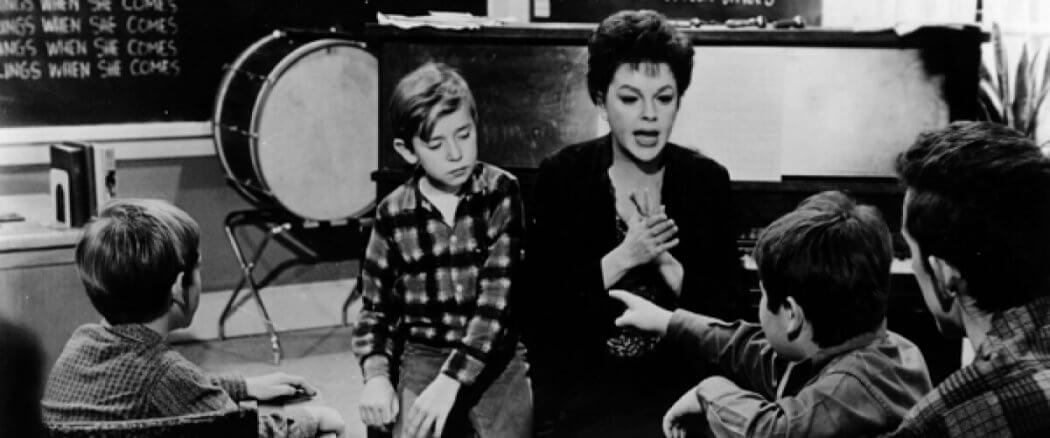The opening title sequence of A Child Is Waiting is a series of striking children’s drawings, primal and observant, done with the pencil pressed hard. At the end of it, the camera pushes in on a picture of a black cloud, not unlike the shape of a brain, that dissolves into a close up of Jean Hansen (Judy Garland). It’s a moment like a piece of sushi – small, full of ingredients both identifiable and un: Jean is in a dark mood, and she is entering a children’s world of a different mindset, which will change hers.
The setting is, in the language of 1963, an institution for mentally retarded children, though its approach is progressive. Jean, a woman in her thirties in a job interview for a sort of teacher-housemother position, is “unsure of herself, underconfident, much like the real Judy Garland.”* “What makes you think you want to work here?” The interviewer interrogates, “I mean the real reason.” “Well,” Jean responds, “let’s just say that all my life I’ve tried to find something to give meaning. So far I’ve been unsuccessful.”
This is a tragic reason for attempting such important work. The tragedy is not in the motivation, really, but the hierarchical understanding of love, wherein the “giver” is rewarded in privilege, the “receiver” is robbed of autonomy, and all are devalued. It’s toxic enough in a brief interaction, but in an ongoing relationship, it curdles into codependency.** Love requires discipline, of self and others.
Love Is Not Enough
Soon after Jean’s arrival, a patient named Reuben Widdicombe (Bruce Fitchey) emotionally and physically attaches to her. Dr. Matthew Clark (Burt Lancaster) has strong methods and Jean has a soft heart, so almost immediately they begin arguing about how best to treat Reuben. When Jean disobeys one of Matthew’s orders, there are consequences for everyone. “You want to coddle them,” Matthew blasts her, “you want to take the falls for them, you want to suckle them at your breast, you want to give them your love. Well your love is not enough. They need more than that. More than that.”
By now your patrimalarkey alert is flashing, and it should be. What a narrow view of gender, parenting and affection, right? But it also functions as a periscope, focusing on a challenging truth: love must protect and it must discipline. In this non-parent’s opinion, the best parenting arises in the tension. And since we’re on the subject of tension…
Message Pictures
The film’s producer, Stanley Kramer, “was famous for his message pictures,” Michael Van De Bos says to fellow film historian Tom Charity in the film’s audio commentary. “There’s that old Hollywood phrase,” Charity replies, “if you want a message, call Western Union. But in fact you’d be better off calling Stanley Kramer.”
 Kramer’s calling card is high profile, but a bit too on the nose – Guess Who’s Coming to Dinner, High Noon, Inherit the Wind, Judgment at Nuremberg – films that seem to be looking down at you, even though it’s for a good cause. Conversely, Director John Cassavetes believed it was his responsibility as filmmaker to be an innocent bystander, regarding messaging as a betrayal of reality.
Kramer’s calling card is high profile, but a bit too on the nose – Guess Who’s Coming to Dinner, High Noon, Inherit the Wind, Judgment at Nuremberg – films that seem to be looking down at you, even though it’s for a good cause. Conversely, Director John Cassavetes believed it was his responsibility as filmmaker to be an innocent bystander, regarding messaging as a betrayal of reality.
But in 1963, as Cassavetes was rebelling into that style and Kramer was fully settled in his own, together they accomplished, in my estimation, their most interesting work: a film tugging between the studio system technique and the new wave sensibility, urging a change of heart in its audience and just trying to show the heart of its characters. And they showed pictures of the children.
They’re Just Being Themselves
Though Lancaster and Garland receive top billing in the film, there is no doubt the stars are the children. In actuality, that was “crucial to the disagreement between Kramer and Cassavetes…Kramer apparently was very uncomfortable with the amount of…footage that Cassavetes wanted to include of the children, and particularly uncomfortable with the idea that people might laugh at them, whereas Cassavetes felt, yes, that behavior is funny. And there’s nothing wrong with that. It’s natural behavior…they’re just being themselves.”***
A friend of mine has a mild developmental disability that makes it difficult for her to keep a job, to live alone, to remember. Although she is 30 years old, her parents still feel a constant responsibility. She has an infectious laugh, and a way of phrasing things. When we were children, we used to have “crazy tea parties” where mostly we just toppled out of chairs, spilled teacups of water and laughed, because we were funny. As a twentysomething, she made snowballs in winter, stored them in her freezer until summer and then had a snowball fight with her boyfriend. For all the years of her life, her family and friends have struggled to listen, help, instruct and discipline: to love. And God has used her simplicity to confound our wisdom.
Screenwriter Abby Mann, whose regular visits to an institution inspired the film, is familiar with the handicap of such wisdom. Towards the end, there is a line so clear you know it is one of his core beliefs: “I think you can find what you’re looking for here…because it’s not what you can do for these children; it’s what they can do for you.”
__________________________________________
*Michael Van De Bos in the audio commentary of A Child Is Waiting.
**On this subject, I urgently recommend When Helping Hurts by Steve Corbett and Brian Fikkert and Toxic Charity by Robert D. Lupton.
***Tom Charity in the audio commentary of A Child Is Waiting.




